October 29, 2004
A Jaws-like Mako
Check out the picture of this huge Mako caught off of Nova Scotia. I wonder what they were using for bait... Reminds me of the time when Brian, Steve, and I used some beef blood to make a bait slick when we went fishing off of the pier next to UCSB. We didn't catch a thing, but then again who catches great stuff off of piers anyways? At least we had a few 6 packs.
October 20, 2004
Humbolt Squid off of Long Beach
If you live in Los Angeles and you want to go fishing for squid, right now is the time to do it- apparently these large squid were spotted as far North as Washington state. If you want to go salt water fishing, then you have a free source of bait waiting for you on the beach. The seagulls must be having a feast! Fishing for Humbolts would kick the pants off of cuttlefish fishing on Awaji, but I still wouldn't go squid fishing even if I had the chance. They just can't fight that well, and there's always the possibility of being shot with a stream of brine, or even that nasty ink. Still, they are cool to watch as they hover around and hunt the baitfish in the harbor.
October 15, 2004
Fishing Awaji Shima

The gokai, AKA bloodworm, is a nasty looking worm that looks pretty threatening. In addition to its abundance of legs and segments, it has a vein running the length of its translucent body that pulses blood down from head to tail. Its mouth looks like the Predator's, and when you touch it the worm will whip around and try and bite you.
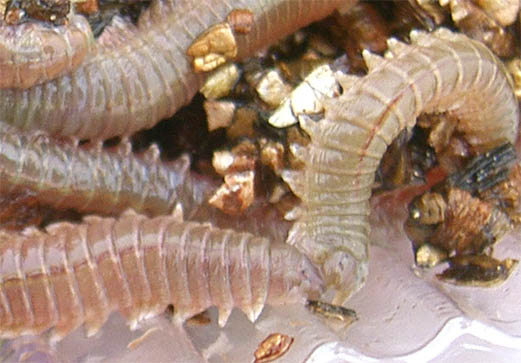
It only took me three days to work up the courage to pick up the whole worm without using pliers. Actually, I guess it doesn't really hurt if they bite you but it looks like it does. So what can you catch around here, along the coast where everyone goes to dip their lines? You can catch as many fish as you like, as long as you don't mind that they're all going to be small.
The Japanese fisherman has a different mentality than the casual American sports fisherman. When he goes fishing, he means business. Armed with his 20 foot rod, bucket of chum slurry, and 5 hooks on his line all baited with either krill or gokai, he methodically plucks 2-3 inch fish from the seawall and puts them in his bucket. Using his flourescent, multihooked squid jig, he tirelessly snags cuttlefish that occasionally protest by spitting out their oily ink. He stares suspiciously at the passing stranger carrying a fishing pole, practicing his telepathic "go away, dick" stare, sneering in contempt of his meager 6 foot freshwater rig. Yes, the Japanese fisherman plays for keeps- none of this catch and release nonsense for him. If it's edible, it's getting cooked and eaten tonight. The reason that there are few big fish out there is that they've all been caught and eaten already, most of them before they had a chance to get big.
That way of fishing is not good enough for me. Fishing is about going out and relaxing, having a good time with friends and about connecting with nature. Fishing is about catching fish in unexpected places and ways, developing your own personal methods. Fishing, done the right way, leads to epic adventures and ridiculous tales recalled over sizzling barbecues and beers. That's why were taking fishing back on Awaji-shima. Instead of going for two inch fish off of the seawall we are going to target the 20 pound carp, jumping mullet, and catfish that swim in the scummy river. We will hook the bass, trout, and char that lurk in the freshwater dams. We will close in on the big fish that eats the abundance of small fish that everyone at the seawall hunts relentlessly. Then, perhaps, the man with the 20 foot pole will look up and realize he has been missing out on something when he sees us having the time of our lives fighting to land something that we don't intend to eat. Perhaps the next time he catches one that is too small, he will release it to fight another day.
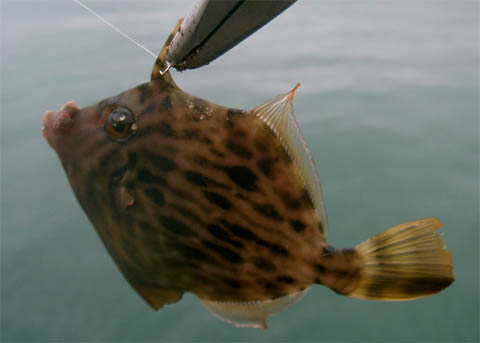
This strange looking horned-triggerfish, called a kawahagi, quacks like a duck. It will live to fight another day.
October 14, 2004
Starbucks Clone
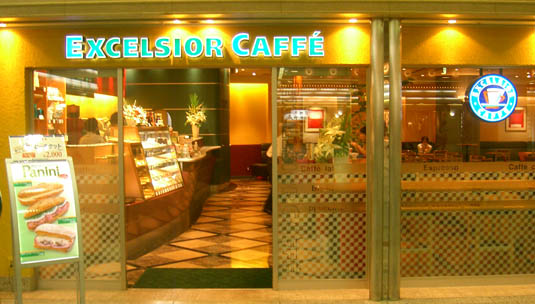
It was bound to happen, right? I mean, many successful chains and brands have to put up with people ripping off their designs or ideas. In-N-Out was ripped by Volks in Japan (which doesn't even serve anything you can get at In-N-Out), Dr. Pepper has Mr. Pibb, Dr. Grip pens were copied by PHD, but the mother of these has to be The Original Tommy's World Famous Hamburgers. I wish we had taken photos, but when I was 10 years old, Kohei, my dad, and I took a survey of the Los Angeles area looking for Tommy's knockoff restaraunts, and what we saw was a wealth of not-so-subtle immitation: Tommie's, Tammy's, Timmy's, Tomy's, Tom's, and Sammy's are just some of the "Original World Famous" hamburger joints where we ate at. The amazing thing is that the buildings all copied the look of a Tommy's joint, but they all lacked the funky soul of the real thing. By the way, if you don't know what I'm talking about, the next time you're in So Cal do yourself a favor and stop by here, or make your own with this recipe and if you truly want the authentic recipe, refer to FAQ no.4 on the official site.
Yes, love it or hate it, Starbucks is a very successful company which you wish you had bought stock for 10 years ago. I wonder how many people sit down here, leisurely sip their coffee and read their newspaper, and walk out, only afterwards noticing that this place isn't Starbucks but a place that uses a very similar font and color and goes so far as to immitate the circular mark of Starbucks, replacing the crowned Medusa mascot with a stylized cup of coffee. I wonder how many people never notice this and continue to believe that they are drinking at Starbucks, when in fact they are doing no such thing. This immitator isn't even the best one I've seen. That one is called something like "Coffee Factory" but I think it has a slight edge because they also dip into the boba drink market (that would be "bubble tea"). If you are driving down Bolsa Avenue in Little Saigon, it is in the strip mall with Taco Bell and Hair perfection. Not that I recommend this place, as I have heard that their coffee sucks, but if you're going to Taco Bell anyways...
Immitation is not the highest form of flattery- it is a justified form of slight theft. Parody, is an outright bitchslap.
October 13, 2004
Kushiyaki in Shinsekai
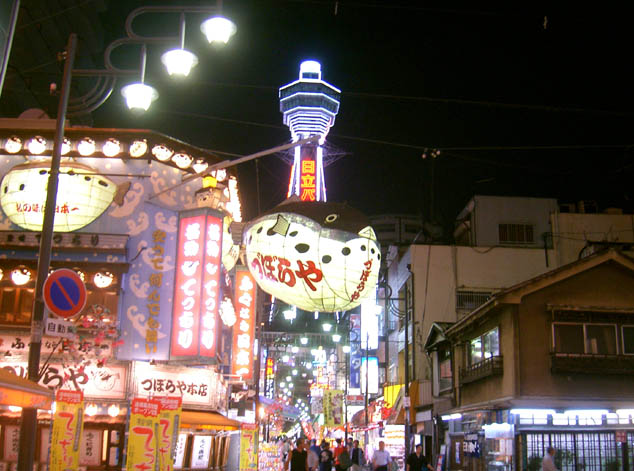
Shinsekai means "new world", and I can only imagine how striking this area must have been when it was new, a long, long time ago. Giant puffer fish(not called fugu in this area) lounge around a dense arrangement of lights, some street looking Japanese people hanging around, dark alleys cutting between the subdivisions on the block, and attractions reminiscent of carnivals in their heyday. Glare and inky darkness create a dystopic atmosphere in Shinsekai, bringing back snippets of Chinatown, Blade Runner, The Replacement Killers, Idoru (William Gibson), and other Noir works. I wonder how the food was in those world's back alleys- Either Gibson or Stephenson wrote that most of the food available in his Shinsekai-like neighborhood was made of processed krill...
There must be about 10 different joints where they serve kushiyaki (skewered-fried food in the same family as shishkabobs and corndogs, but of different parentage) under the gaze of Tsutenkaku Tower, but the best looking one was the one where all of the locals were waiting to get in, right down this street. A huge counter surrounds the kitchen that runs down the middle of the length of the izakaya. The kushiyaki runs from 80 yen (regular fried pork cutlet and beef tendon- this item isn't kushiyaki- stewed in a miso stew) to just over 200 yen per skewer (for more expensive stuff). You can sample so much for quite a reasonable price. The majority of the kushiyaki are prepared by frying them in panco, the bread crumbs that are used to coat tonkatsu.
It is unusual in Japan to have one of those food experiences where you wonder "Is it safe and sanitary to eat this?" (unlike the typical uninitiated gaijin question "Isn't it supposed to be cooked/ not rotting/ dead when they serve it?"). Japan is typically the land where they will thourally package everything at least four different ways and use disposable wetnaps for every meal. Here, in the kushiyaki joints, the dipping sauce is shared in communal troughs with strangers and friends alike. Pools of swirling oil shimmer on top, and other random detritus can be seen floating, suspended in the collodial middle of the sauces thermoclamatic strata, or felt on the bottom by probing the benthosphere.
Like all wonderful late night culinary adventures, this place is best enjoyed over several mugs of beer. Beer tastes better with kushiyaki, and vice versa. And if you have any urge to satisfy your curiosity regarding something you would usually never eat, the beer will help you to go for it, and also serves as something to wash a bad experience past your mouth and into your gut. Using this very method, I was able to overcome killing, cleaning, and eating a live shrimp that quivered as it was digested inside my stomach, eat pig's feet (the best thing I ate in Okinawa BTW) and other parts of the hog in their recognizable states that are usually reserved for the production of sausage, develop an appreciation for hormone (intestines) and every other type of innard prepared the proper way (I will never like cooked liver or kidneys, ever), and started to crave basashi (horse sashimi), grilled horse meat, and basashi liver. If you are content with eating exclusively out of McDonalds and convenience store food and have a need to use wetnaps before and after every meal, you will probably never understand what I'm talking about.
Oh, and just in case:
*Basashi should be enjoyed by wrapping it in a shiso leaf with paper-thin slices of tamanegi (onion) and dippped into shoyu with shoga (ginger) mixed into it. Wasabi is optional.
*Basashi liver is best enjoyed with paper-thin tamanegi slices dipped into shoyu with a few drops of goma-abura (sesame oil, the reguar stuff), and wasabi is optional.
*Like any other type of food, there is high-quality hormone and low-quality. If you eat bad hormone you will definetely know it, and the same is true of the good stuff because it will taste pretty good.
*Thanks to J for pointing out the mistakes in this entry.
October 07, 2004
Glazed Pilgrim with a side of Mawmenny, please
Check out this article on Slate today:
Historical Fiction
Quote:
"While a Medieval Times castle seats anywhere from 900 to 1,500 people a night, and the Excalibur's Tournament of Kings about 2,000 (a thousand at each seating), no present-day medieval feast comes even close to approaching the enormity of some of the Middle Ages' heavy-hitters. We don't know exactly how many people attended the marriage feast of Henry III's daughter in 1251, but we do know that they gorged on 1,300 deer; 7,000 hens; 170 boars; 60,000 herring; and 68,500 loaves of bread. Feasters at the enthronement party for England's Archbishop of Neville in 1465 consumed 1,000 sheep; 2,000 pigs; 2,000 geese; 4,000 rabbits; and 12 porpoises and seals. No less than 11,000 eggs were eaten at a 1387 feast for Richard III."
12 porpoises and 12 seals, or 12 combined? Greenpeace demands to know.
October 04, 2004
Black Beauty RX7
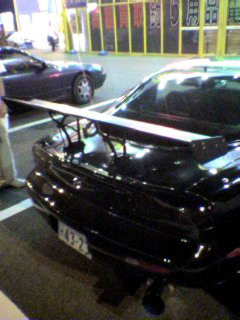
Someone should just sit down and figure out the exact equation detailing the relationship of [number of times dropped on head as child] to [height of rear spoiler on car]. By the way, people with cars this expensive should not be spotted in the parking lots of recycle shops... A more affordable solution for cash-strapped Fast and Fuuurious wannabes is a haxx0red copy of Gran Turismo, aight?